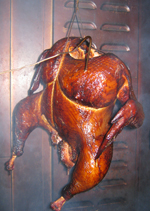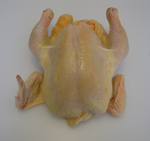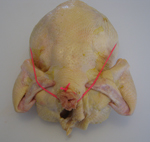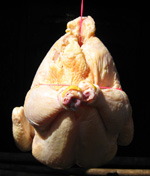Meats and Sausages
Poultry
When overcooked, most meats will have an inferior taste, but poultry is particularly vulnerable because it is so lean. Fortunately, soaking birds in brine - a solution of salt and water will help to achieve a moister, juicier product. If a product will be smoked at low temperatures nitrite (Cure # 1) must be used.
Making Brine
Brine is a solution of water and salt. A sweetener such as brown or white sugar, molasses, honey, maple-flavored sugar, or corn sugar may be added to the solution for flavor. The salt has two effects on poultry, reports Dr. Alan Sams, a professor of poultry science at Texas A & M University. ”It dissolves protein in muscle, and the salt and protein reduce moisture during cooking. This makes the meat juicier, more tender, and improves the flavor. The low levels of salt enhance the other natural flavors of poultry”.
Curing and smoking imparts a unique, delicate flavor and pink color to poultry meat and increases its storage life. Mild cures with relatively low salt content are used in preparation for smoking to maintain the poultry flavor. A light smoke will add to the delicate flavor of the poultry, a heavy smoke will add flavor similar to smoked red-meat products. Poultry is cured by a wet method using mild cure. It is very easy to end up with a product that is too salty. One of the reasons is that the brine is prepared as if poultry were a piece of ham and no consideration is given to the fact that a large part of any bird consists of bones.
The bones are not going to absorb any salt and the curing times need to be shorter. It is safer to brine on the low end of the time range on the first attempt and keep notes for future reference. You can always brine longer the next time if required. To prepare a brine dissolve salt in cold water by mixing it thoroughly (salt dissolves much faster in hot water than in cold water). Cover and refrigerate before adding poultry.
The FSIS (Food Safety and Inspection Service) of the USDA (United States Department of Agriculture) recommends: ”To prepare a brine solution for poultry, add ¾ cup salt to 1 gallon of water, or 3 tablespoons of salt per quart of water. For best flavor use sodium chloride-table salt”. Taking this as common table salt (non-iodized) works out as ¾ of a cup equals 219 g (0.49 lb.). This in turn works out to be a brine concentration of 5.55 % or salinometer reading of 21. A noted expert on sausage making and meat curing, Parson Snows, recommends 1 part table salt to 16 parts water.
1/1+16 = 1/17 = 0.0588 (5.88%)
Using the ratio of 1 lb. of salt per 16 lbs of water (1.92 US gallons) or 0.52 lbs. of salt per US gallon of water equals a brine concentration of 5.88 % or a salinometer reading of 22.5 degrees.
Rytek Kutas presents the following formula in his book:
- 5 gal. water
- 2 lbs. salt
- 1 lb. Cure # 1 (there is 0.93 lb. salt in it)
- 1½ lbs. powdered dextrose and that equals a brine concentation of 6.5% or a salinometer reading of 25 degrees (salt present in Cure #1 is included in calculations).
Dr. Estes Reynolds, a brining expert at the University of Georgia recommends using 9.6 ozs of salt for every US gallon of water for products that brine longer than several hours. This works out to be a brine concentration of 6.68% or a salinometer reading of 25 degrees. There are many sources that recommend using 1 lb of salt to 1 gallon of water. This works out a brine concentration of 10.71% or a salinometer reading of 40 degrees which is rather high if the bird will be brined for more than a few hours.
With salt everyone’s tastes are different, but it can be concluded that any salinometer reading between 17 and 26 degrees will work out fine with the 21 – 22 degrees being in the middle of the safe range. It should be noted that the higher salinometer reading, the saltier the brine.
Products that are going to be smoked at low temperatures (below 200° F, 93° C) need Cure # 1 to be added to the brine. Cure #1 contains 93.75 % of salt which has to be taken under consideration. Using ½ cup of salt and 3 oz. of Cure #1 for 1 gallon of water we obtain a brine concentration of 5.6 % which corresponds to a salometer reading of 21 degrees.
A typical brine solution (with Cure #1) at 21 degrees salometer reading:
- 1 gal. of cold water
- ½ cup (146 g) of salt
- 3 oz. (85 g) of Cure #1 – corresponds to 79 g of pure salt
- 3 oz. (85 g) sugar (brown or white).
A typical brine solution (no Cure #1 added) at 21 degrees salometer reading:
- 1 gal. of cold water
- ¾ cup of salt
- 3 oz. (85 g) sugar (brown or white)
Curing time depends on the size of the bird:
- Cornish Game Hens 1 - 2 hours
- Chicken Pieces 2 - 4 hours
- Whole Chickens (2 lbs.)1 day
- Whole Chickens (4 lbs.) 1 - 2 days
- Turkey Breast 4 - 8 hours
- Whole Turkeys (up to 10 lbs.) 1 - 2 days
- Whole Turkey (over 10 lbs.) 2 - 3 days
- A Very Large Turkey 4 - 5 days
To shorten curing time, poultry may be pumped with a brine mixture in an amount equivalent to 10% of the bird’s weight. A 10 lb turkey should receive 1 lb of brine. Birds weighing less than 3 lbs don’t need to be pumped and can be immersed in a brine mixture.
- Birds weighing 3 - 10 lb
- Each breast – 3 injections 60% of the brine
- Thigh – 2 injections 30%
- Drumstick – 1 injection 10%
- Birds weighing 10 lb or more
- Breast - 3 injections 50% of the brine
- Thigh - 2 injections 25%
- Drumstick - 1 injection 10%
- Wings - 1 injection 10%
- Back (each side) - 1 injection 5%
After the brine has been pumped in, the bird should be massaged lightly with fingers for better distribution of the brine inside.
The curing times for pumped in poultry are as follows
- Birds 3 - 10 lb (injected) 24 - 36 hours
- Turkeys over 10 lb (injected) 48 - 72 hours
The poultry should now be placed in a stainless steel, clay or food grade plastic container and covered fully with the remaining brine (use weight plate if needed). It should be placed in the refrigerator or in case the container is too large, ice should be added periodically to the brine if the temperature goes over 40° F (4° C). Added ice should be taken under consideration if we want to maintain the proper proportion of ingredients in the brine.
Draining And Drying
After curing, the poultry should be rinsed in cold tap water for 5 minutes to remove any crystalized salt from its surface, then it should be left to drain. Poultry holds its shape after hanging in a smoker for many hours and it will look like a bat with spread wings and legs. To retain its original shape it should be placed in a stockinette bag.
Smoking
When the birds are dry or tacky to touch, they should be placed in a pre-heated smoker. Keep the damper wide open to allow moisture to escape. Once the birds feel dry, leave the damper in ¼ open position and smoke at 130° F (54° C) for about five hours. Then continue smoking slowly raising the temperature to 165-170° F (74-77° C) and hold until the inside temperature in the thickest part of the breast is 160° F (71° C). You could insert a thermometer close to the ball and socket joint of the thigh as this is also the last place the meat becomes fully cooked. If the thermometer is not available, you can check the turkey by twisting the leg slightly. If it moves easily, the cooking is done. Small birds like cornish game hens or small chicken will need shorter smoking and cooking times.
And be careful when making stuffing. Let’s follow a beautifully presented scenario on stuffing a turkey from the 1984 classic “The Great Sausage Recipes and Meat Curing” by Rytek Kutas:
“The well-intentioned cook decides to make the dressing for the turkey the night before. This gives her more time to do many other important things the next day. She stuffs the turkey the night before, and places it in the refrigerator to be cooked the next day. Unfortunately, she doesn’t know she is creating ideal conditions for food poisoning. Obviously, the stuffing that she put into the turkey is somewhere between 40° and 140° F. Because the various parts of dressing have some liquid in them, the moisture is also there. Lastly, she sews up the turkey to create a lack of oxygen in its cavity.”
It is that simple to create food poisoning. You can make turkey stuffing a day earlier, just make sure it is left in a refrigerator.
Sodium nitrite (Cure #1) in the brine will cause the poultry meat to become pink when it is smoked or cooked. Keep in mind that nitrite cured meats develop a characteristic cured meat flavor and poultry will taste ham-like. To smoke turkey without Cure #1 higher temperatures are needed to eliminate food poisoning (botulism) that Cure #1 prevents. The turkey should be placed in a smoker preheated to 180° F (82° C) for at least one hour. Then the temperature should be increased to 200-225° F (93-108° C) and smoke is introduced. The turkey breast should be smoked/cooked to an internal temperature of 165° F (74° C). We are now smoking/baking the turkey without worrying about food poisoning.
If a chicken is placed down on a screen it will develop pale marks where the meat was in contact with the screen. This bears no influence on the taste of smoked meat but it looks unnatural. To avoid that poultry should be hung or inserted on a roasting rack. Another problem is that birds have a tendency to spread out their legs and wings and that shape is retained after smoking. When a whole bird is smoked it is a good idea to tie wings and legs in order to make the bird look more attractive otherwise it will look like a bat.
Duck and Goose
Duck and goose are more fatty than turkey and they taste very good when smoked. Follow the same procedures as for smoking turkey.

















